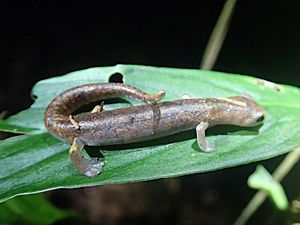Ecuadorian climbing salamander facts for kids
Quick facts for kids Ecuadorian climbing salamander |
|
|---|---|
 |
|
| Conservation status | |
| Scientific classification |
The Ecuadorian climbing salamander (Bolitoglossa equatoriana) is a fascinating type of salamander that lives in the forests of Colombia and Ecuador. These small, moist-skinned creatures are part of a family called Plethodontidae, known as the "lungless salamanders" because they breathe through their skin!
Contents
What is a Salamander?
Salamanders are amazing amphibians, just like frogs and toads. They are known for their smooth, moist skin and long tails. Most salamanders need to live near water or in very damp places because their skin needs to stay wet to help them breathe. Unlike many other animals, salamanders can even regrow lost body parts, like tails or limbs!
The Lungless Salamander Family
The Ecuadorian climbing salamander belongs to a special group called Plethodontidae. These are often called "lungless salamanders" because they don't have lungs to breathe air. Instead, they breathe right through their skin and the lining of their mouths. This means their skin must always stay moist, which is why they love humid, wet environments.
Where Does It Live?
The Ecuadorian climbing salamander makes its home in the warm, wet lowland forests of two South American countries: Colombia and Ecuador. These forests are often called "subtropical or tropical moist lowland forests." Imagine a place with lots of tall trees, thick plants, and plenty of rain – that's the perfect home for this salamander!
A Home in the Trees
As its name suggests, the Ecuadorian climbing salamander is good at climbing. It often lives high up in the trees, among the leaves and branches, or sometimes on the forest floor among damp leaves and logs. Its ability to climb helps it find food and stay safe from predators.
Why is it Threatened?
Sadly, the Ecuadorian climbing salamander is facing challenges. Its biggest threat is habitat loss. This means the natural places where it lives are disappearing.
What Causes Habitat Loss?
Habitat loss happens when forests are cut down for farming, building new towns, or other human activities. When the trees are removed, the salamander loses its home, its food sources, and the moist environment it needs to survive. Pollution and climate change can also harm its habitat.
Protecting the Salamander
Scientists and conservationists are working to protect the Ecuadorian climbing salamander and its forest home. This often involves setting aside protected areas where the forests cannot be cut down, and educating people about the importance of these unique creatures and their habitats. By working together, we can help ensure these amazing climbing salamanders continue to thrive for future generations.
See also
 In Spanish: Bolitoglossa equatoriana para niños
In Spanish: Bolitoglossa equatoriana para niños


